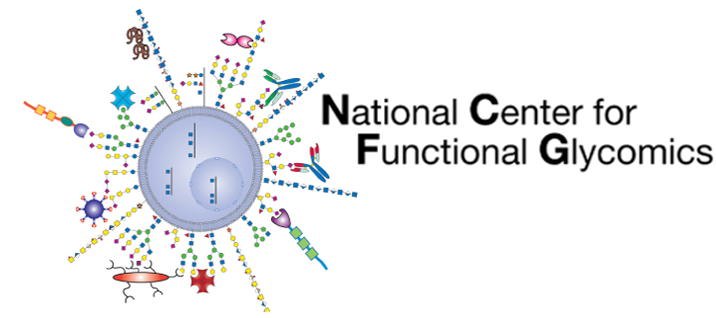By: Richard D. Cummings
Many different monosaccharides from trioses (3-carbon) to decoses (10-carbon) and above are found in nature (1). The most famous nonose (9-carbon) in human glycans is N-acetylneuraminic acid (Neu5Ac) also termed sialic acid. The name sialic acid derives from its discovery in saliva (Greek for saliva, σίαλον - síalon), as a component of bovine submaxillary mucin by Gunnar Blixt in 1936 (2). Blixt coined the term sialic acid in 1952 (3). Ernst Klenk had also discovered it in ganglion cells of the brain and named it neuraminic acid, and its presence led to the naming of brain glycolipids as gangliosides, i.e. glycolipids with sialic acid. [See the paper by Schnaar and Lee for more on this fascinating history (4).] Neu5Ac is ubiquitous in human glycoproteins both secreted and membrane bound and in human glycolipids.
Another nonose found in animals is N-glycolylneuraminic acid (Neu5Gc) (5). It is commonly produced in many mammals and other organisms, and is not made by humans, as we lack the CMP-N-acetylneuraminic acid hydroxylase, the rate-limiting enzyme in generating Neu5Gc (6). There is evidence, however, that Neu5Gc can be taken in through our diet and incorporated into human glycoproteins (7). The presence of Neu5Gc in humans is correlated with the consumption of red meat as it is common in animals, and its consumption is correlated to some inflammatory responses (8). If Neu5Gc is present in biotherapeutic glycoproteins it could be problematic as some people have antibodies to Neu5Gc (9).
Another major nonose found in animals is KDN (2-keto-3-deoxy-D-glycero-D-galacto-nononic acid). It cannot be synthesized by humans (10). Whether it occurs in human glycans is unclear. Recent evidence indicates that KDN can be found in human adipose tissue samples (10), presumably from the diet, but the source(s) are not yet rigorously defined and the evidence needs to be corroborated. Interestingly, there is evidence that KDN, which is a product of mannose-metabolic pathways, can be found in free form in urine (11). In addition, antibodies to KDN are found in humans (11).
The potential of other non-human monosaccharides or their homologs to be incorporated into glycomolecules of animal cells is a possibility worth considering. As evidenced by the use of bioorthogonal labeling strategies, whereby monosaccharide precursors mimicking normal sugars but having azido- or other modifications, unusual sugars can be taken up by cells and incorporated into glycoproteins and glycolipids (12,13). A particularly novel example is FucAz (6-azidofucose), which can be incorporated by cells into GDP-FucAz, transferred to glycoproteins, which permits labeling with click-activated fluorogenic probes or biotinylated alkyne (14). These studies further enhance the possibility that unusual monosaccharides derived from glycomolecules in the diet could possibly be taken up and incorporated into human glycoproteins, but outside of Neu5Gc and KDN mentioned above, this general possibility has not been extensively documented.
References
- Cummings, R. D. (2024) A periodic table of monosaccharides. Glycobiology 34
- Blix, G. (1936) Über die Kohlenhydratgruppen des Submaxillaris mucins. Z Physiol Chem. 240, 43-54
- Lundblad, A. (2015) Gunnar Blix and his discovery of sialic acids. Fascinating molecules in glycobiology. Ups J Med Sci 120, 104-112
- Schnaar, R. L., and Lee, Y. C. (2017) Discoveries of the structures of sialic acid and CMP-sialic acid (1957-1960): a letter from Saul Roseman. Glycobiology 27, 513-517
- Awofiranye, A. E., Dhar, C., He, P., Varki, A., Koffas, M. A. G., and Linhardt, R. J. (2022) N-glycolylated carbohydrates in nature. Glycobiology 32, 921-932
- Varki, A. (2001) Loss of N-glycolylneuraminic acid in humans: Mechanisms, consequences, and implications for hominid evolution. Am J Phys Anthropol Suppl 33, 54-69
- Bardor, M., Nguyen, D. H., Diaz, S., and Varki, A. (2005) Mechanism of uptake and incorporation of the non-human sialic acid N-glycolylneuraminic acid into human cells. J Biol Chem 280, 4228-4237
- Tangvoranuntakul, P., Gagneux, P., Diaz, S., Bardor, M., Varki, N., Varki, A., and Muchmore, E. (2003) Human uptake and incorporation of an immunogenic nonhuman dietary sialic acid. Proc Natl Acad Sci U S A 100, 12045-12050
- Yehuda, S., and Padler-Karavani, V. (2020) Glycosylated Biotherapeutics: Immunological Effects of N-Glycolylneuraminic Acid. Front Immunol 11, 21
- Guerrero-Flores, G. N., Pacheco, F. J., Boskovic, D. S., Pacheco, S. O. S., Zhang, G., Fraser, G. E., and Miles, F. L. (2023) Sialic acids Neu5Ac and KDN in adipose tissue samples from individuals following habitual vegetarian or non-vegetarian dietary patterns. Sci Rep 13, 12593
- Kawanishi, K., Saha, S., Diaz, S., Vaill, M., Sasmal, A., Siddiqui, S. S., Choudhury, B., Sharma, K., Chen, X., Schoenhofen, I. C., Sato, C., Kitajima, K., Freeze, H. H., Munster-Kuhnel, A., and Varki, A. (2021) Evolutionary conservation of human ketodeoxynonulosonic acid production is independent of sialoglycan biosynthesis. J Clin Invest 131
- Saxon, E., and Bertozzi, C. R. (2000) Cell surface engineering by a modified Staudinger reaction. Science 287, 2007-2010
- Pedowitz, N. J., and Pratt, M. R. (2021) Design and Synthesis of Metabolic Chemical Reporters for the Visualization and Identification of Glycoproteins. RSC Chem Biol 2, 306-321
- Sawa, M., Hsu, T. L., Itoh, T., Sugiyama, M., Hanson, S. R., Vogt, P. K., and Wong, C. H. (2006) Glycoproteomic probes for fluorescent imaging of fucosylated glycans in vivo. Proc Natl Acad Sci U S A 103, 12371-12376
